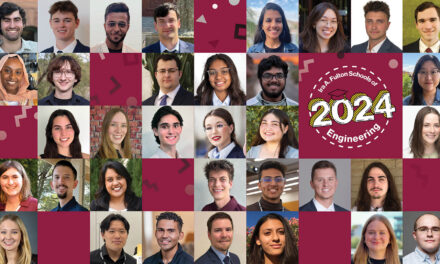
Grand Challenge Scholar takes on big problems, starts business venture
Reverse-engineering the brain was continually on Markey Olson’s mind as she engaged in research, community service and entrepreneurial efforts in the Grand Challenge Scholars Program (GCSP) at Arizona State University.
In 2008, the National Academy of Engineering (NAE) identified reverse-engineering the brain as one of 14 “Grand Challenges for Engineering in the 21st Century.”

Markey Olson pictured with her team’s Braille-teaching tool, called VisiBraille, at the School of Biological and Health Systems Engineering’s senior capstone presentations. Photographer: Jessica Hochreiter/ASU
ASU’s Ira A. Fulton Schools of Engineering is among 20 leading engineering schools to establish an undergraduate program guided by the NAE’s Grand Challenges. GCSP now serves as the Fulton Schools of Engineering Scholar Academy—an individualized program for high-achieving engineering students.
This spring, Olson became the program’s second graduate, receiving a bachelor’s degree in biomedical engineering. That made her the first to graduate from the inaugural group of freshmen students invited into GCSP.
“As a Grand Challenge Scholar I participated in a variety of experiential learning opportunities generally not afforded to an undergraduate student,” Olson said.
Five program components that each student must complete provide the variety: conducting research related to each student’s chosen Grand Challenge; exploring interdisciplinary coursework; gaining an international perspective; engaging in entrepreneurship; and giving back to the community through service learning.
“Students completing the program become well-rounded engineers who not only have technical expertise, but also an interdisciplinary perspective and social consciousness that prepares them to work on global problems that impact society,” said Amy Trowbridge, GCSP program director and lecturer in the Fulton Schools of Engineering.
Brain function research
Olson decided to focus on reverse-engineering the brain because the brain is critical to a multitude of bodily functions.
“By reverse-engineering the mechanisms that help our brains operate properly, engineers can help treat a wide variety of disabilities in a range of ways,” she said.
Since her sophomore year, Olson has been conducting research in neural connections to help develop ways of providing tactile feedback to users of prosthetics.
“A non-amputee is able to use tactile feedback to grasp and discriminate between objects without visual cues, but prosthetic users are often unable to accomplish tasks that involve grasping and identifying while they are looking at something else,” she explained.
Olson’s research aims to solve this problem by using sensory cues as opposed to visual cues.
“I have been working to better understand the neural connections that help people orient their grasp relative to object size in hope of creating a prosthetic hand capable of providing haptic cues that can simulate tactile feedback,” Olson said.
Interdisciplinary, global-minded coursework
To meet GSCP’s interdisciplinary and global dimension components, Olson completed a variety of relevant coursework. In a class on complex legal and societal issues related to the field of genetics, Olson brought her biomedical engineering background to a classroom composed of students in law, medical and physical sciences programs.
“This ensured that we approached the issues from a variety of angles, including policy considerations, scientific limitations, moral and human rights concerns, and even insurance coverage implications,” Olson said.
Interdisciplinary coursework taught Olson that engineers cannot solve the world’s problems on their own.
“Engineers, like all professionals, need to communicate with the public and with people in other disciplines to learn from different vantage points,” said Olson.
In addition, Olson met GCSP’s global dimension component by taking classes related to global health and worldwide issues in science and technology.
Olson’s main take-away from those classes was the realization that research and product development efforts must take into account the effects a product can have across a range of cultures, political climates and ideological beliefs.
Service-learning through EPICS
ASU’s Engineering Projects in Community Service (EPICS) program helped Olson to complete the GCSP’s service-learning requirement. During her freshman year she worked with a local warehouse operation that ships used medical equipment from hospitals and medical centers in the United States to countries without adequate medical supplies.
During her last three semesters, she joined a team called Project Maji, which was developing a product to treat water for the Nyagoma School for the Deaf in Bondo, Kenya.
Unfortunately, the project failed to produce a successful prototype due to a lack of communication between the Project Maji students and the school in Kenya, which lacked access to modern communications technology.
Despite the difficulties, Olson credits her EPICS experience with helping her develop a level of leadership, product design and presentation skills that she would likely not have obtained in a traditional classroom.
Recently those skills have proved invaluable as Olson works on her own entrepreneurial venture.
Venture for the visually impaired
Classes on topics related to entrepreneurship and her biomedical engineering capstone course enabled Olson and two other biomedical engineering seniors, Alyssa Oberman and Robert Valenza, to turn their senior capstone project into a startup company called VisiBraille.
“VisiBraille is a Braille-teaching tool that allows parents and teachers, who may not know Braille themselves, to teach Braille to visually impaired students,” Olson said.
The idea developed as she taught Braille to her visually impaired sister.
Although the tool is designed to facilitate learning, Olson relates it to her chosen Grand Challenge because “it’s essential to first understand the neural mechanisms at play,” she said.
“To create this device we had to develop a basic understanding of the neural pathways that are active during learning, and while reading Braille. Then we studied what educational methods can be used to stimulate these pathways,” she explained.
The venture team is now at work on the manufacturing and distribution systems needed to get the VisiBraille device into the marketplace.
Olson said her work in the Grand Challenge Scholars Program has equipped her to contribute to solving some of society’s most critical problems.
She plans to continue work toward the solutions through her startup venture and by beginning a doctoral program in biomedical engineering at ASU next year.
Learn more about the Grand Challenge Scholars Program



































